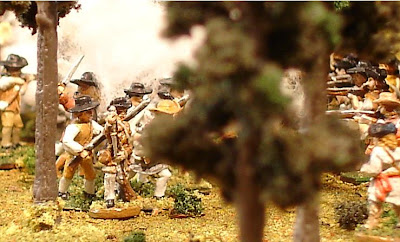At the same time that elements of the Americans center and left divisions were battling McCulloch for possession of the Loyalist camp, other American militia were pursuing Samuel Bryan’s Loyalists to the west and south. These panicked men threw the camps of the Provincials into disorder [1]. Amid the chaos, the Provincials mistook some of Bryan's men for Sumter's militia and shot them [2]. The Americans added to the confusion by closing pursuing Bryan's men. According to one remarkable tale told after the war:
"As the tories fled towards the British camp, many of the whigs [i.e., Sumter’s men] rushed pell-mell with them. One named Walker, hurrying along in their midst, was about to fire on those before him, when a tory close to him caught his arm, crying, ‘Those are on our side!’ and then, as if struck with a sudden suspicion, asked ‘What is that green leaf in your hat for?’ The whigs had taken the precaution to put each a leaf in their hats that morning before going into battle. The soldier pulled out the token, but the discovery was already made; one of the tories seized his gun, the other ran a bayonet through his hunting shirt. Letting the weapon go, he turned and fled back. ‘It appeared to me,’ he said, ‘that they fired fifty guns after me; every leap I gave, I heard something fall on the leaves which I took for blood, and thought I must be badly wounded, and would soon fall exhausted. I thought of the intolerable thirst I had witnessed in those bleeding to death, and my mouth began to feel parched. I had now reached the branch [Hanging Rock Creek or a tributary], and stooped to drink. On examination I found I was not hurt, but my powder horn was severely wounded, being pierced through with a rifle ball, and having lost the greater part of its contents’" [3].
The American right division followed those of Bryan's men fleeing westward. For Richard Winn, the purpose of this movement was to attack the British center camp, his original target [4]. Here, the British "were well posted" [5]. When the Americans came into view, "the British immediately commenced firing from behind some bush tents," [6] and "behind a fence" [7]. Many of the men with Winn were simply moving "in pursuit of the Tories," and were surprised "by this unexpected discharge" from the Provincials [8]. But the Americans were quick to recover. Seeing that the Provincials were without loaded muskets, Winn "set up the Indian hollo," and his men "rushed and fire[d] on their enemy as they went with bullets in their mouths and powder in their pockets." They loaded their rifles on the run, not stopping "to take a tree even where trees was" [9]. "The British… finding such a charge made on them," [10] "broke and joined in the flight of the Loyalists" [11].
Elements of the center and left divisions soon began arriving after having pursued the survivors of McCulloch’s company to the center camp [12]. Among these, two companies of North Carolinians began taking fire from "A party of fifteen or twenty of the enemy," who had taken "shelter in a cabin with a clapboard door," and were "firing through the cracks." In response, "Captain [James] Knox, with half the men, charged the front door, Lieutenant [George] Graham with the rest charged the rear door. Captain Knox ran against and broke down the door, the enemy fled out of the rear door, and Graham's party shot down several of them" [13].
All-in-all, the Provincials had delivered only "a few discharges," before giving up the center camp. They retreated "for about 300 yards." Here, Joseph Graham thought, was the opportunity to launch the knockout blow against the British garrison. The British infantry "turned their backs for 300 yards," and "a charge of 70 cavalry would have made them surrender, but at that period but few of the cavalry had returned from pursuit of the tories and they were yet unformed." That Davie’s dragoons had charged and scattered so early in the action was a "great blunder" for the Americans [14].
Notes:
1. Charles Stedman. (1794). The History of the Origin, Progress, and Termination of the American War, Vol. 2.
2. The pension application of Samuel Saxon, transcribed by Will Graves.
3. Elizabeth Fries Ellet. (1850). Domestic history of the American Revolution.
4. Suggested by the accounts of William Davie and Richard Winn; both describe early attack on center camp, and neither mentioned the battle with McCulloch described in my previous post. Winn's account notes, "as soon as Brian gave way [Winn] marched with his party for the British camp which he found in an open old field about [one] half mile from where Brian was posted." For Davie's account, see The Revolutionary War Sketches of William R. Davie [extract]. Davie's account also appears in, John H. Wheeler. (1851). Historical Sketches of North Carolina from 1584 to 1851, Vol. 1. For Winn's account, see General Richard Winn's Notes -- 1780, transcribed by Will Graves. (See here for images of the original document).
5. Letter from Thomas Sumter to Thomas Pinckney, August 9, 1780.
6. Winn, ibid.
7. Davie, ibid.
8. Davie, ibid.
9. Winn, ibid.
10. Winn, ibid.
11. Davie, ibid.
12. Implicit in the account of Joseph Graham, and explicit in the account of Joseph McJunkin. For Graham's account, see William A. Graham (1904). General Joseph Graham and His Papers on North Carolina Revolutionary History. For McJunkin's account, see Will Graves. (2005). What Did Joseph McJunkin Really Saye? Southern Campaigns of the American Revolution, Volume 2, Issue 11.
13. Graham, ibid. According to this source, Knox commanded one company, Graham the other. Graham took over Captain David Reid’s company after Reid was killed in the assault on Bryan’s camp.
14. Graham, ibid.













